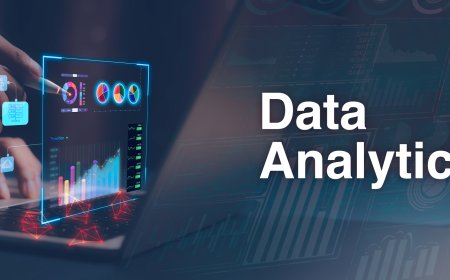The Scope of Data Analytics in Current Business
Explore the expansive scope of data analytics in modern business. Discover its applications, benefits, and impact on decision-making.

The field of data analytics is always changing because a growing number of businesses are realizing how important it is to make decisions based on data. Fundamentally, data analytics examines unprocessed data to identify important trends, patterns, and insights. Organizations can use this information to promote creativity, simplify methods, and make well-informed decisions.
The growing volume, velocity, and variety of data collected is a significant feature of the changing environment of data analytics. The emergence of digital platforms such as social media and the Internet of Things (IoT) has led to an unmatched generation of vast volumes of data. To fully utilize the potential of this data, organizations face both possibilities and limitations.
Technological developments have changed data analytics using advanced analytics technologies including machine learning, artificial intelligence, and statistical analysis. These technologies solve the problems caused by the data flood by more correctly and effectively extracting insights from complicated data.
The challenges businesses face in using the full potential of data analytics
-
Data Volum and Diversity:
The volume and differences of data make managing and integrating data from multiple sources intimidating. Firms must invest in scalable systems and dependable data management technologies to properly handle the data flood.
-
Data Quality and Consistency:
Reliability and quality control of data are necessary for correct inferences and decision-making. Maintaining the security of the data involves the creation of standard data management systems and strong data quality control methods.
-
Talent Shortage:
The scarcity of skilled employees with experience in data analytics creates important challenges for companies looking to use data to their advantage. Organizations must fund talent growth programs and promote a system of ongoing learning to upskill current staff members to meet this challenge.
-
Regulatory Compliance:
Paying particular importance to data privacy and security protection is a must when managing complicated regulations like the CCPA and GDPR. To maintain compliance with regulatory obligations and reduce legal risks, businesses need to put in place robust security frameworks and audit their data practices regularly.
-
Cultural Barriers:
A society that is based on data and capable of overcoming opposition to change is necessary for the effective execution of data analytics projects. Choosing internal communication and offering thorough training to staff members is crucial for organizations to raise employee knowledge of the advantages of data-driven decision-making.
-
Cost Considerations:
It can be expensive to implement advanced analytics tools, particularly for smaller businesses with smaller resources. Companies need to make sure that their long-term viability is maintained by carefully analyzing both the benefits and drawbacks of various analytics solutions and selecting flexible options that fit within their financial limitations.
Challenges for businesses in data analytics include the amount and quality of data, a shortage of skills, cultural differences, cost, and regulatory compliance. To effectively use data analytics to generate creativity and establish a competitive edge, it is important to address these difficulties through savings, regulatory procedures, cultural change, and cost-effective solutions.
What are the key applications of data analytics across industries?
Data analytics is transforming operations and decision-making processes with an extensive range of applications across industries:
-
Healthcare: Through the analysis of medical records, the likelihood of sickness problems, the optimization of medical schedules, and the identification of high-risk patients for preventive actions, data analytics in healthcare improves patient care.
-
Retail: To increase client satisfaction and maximize income, stores use data analytics for forecasting demand, managing stock, specific marketing campaigns, and customer segmentation.
-
Finance: Data analytics is used in finance to improve business productivity and minimize risk through the use of identifying fraud, risk assessment, automated trading, customer segmentation, and specific financial services.
-
Manufacturing: To minimize costs, increase productivity, and reduce delay, manufacturers use data analytics for network optimization, quality control, scheduling production, maintenance prediction, and process management.
-
Telecommunications: For improved customer experience and efficiency in operation, technology businesses use data analytics for network optimization, customer loss prediction, targeted marketing, service quality improvement, and predictive maintenance.
-
Transportation and Logistics: Data analytics helps minimize costs and improve the quality of service in transportation and logistics by supporting projections of demand, fleet management, predictive maintenance, network visibility, and route optimization.
-
Energy and Utilities: To increase performance and the environment, energy and electrical companies use data analytics for smart grid management, demand projections, asset performance monitoring, energy consumption optimization, and predictive maintenance of networks.
-
Marketing and Advertising: To target the correct audience and improve the performance of campaigns, data analytics are commonly used in marketing and advertising for market segmentation, campaign optimization, customer behavior analysis, sentiment analysis, and ROI measurement.
-
Education: To improve learning results and educational quality, data analytics is used in education for personal learning, course optimization, student retention analysis, and resource allocation.
-
Government: To improve governance and the delivery of public services, governments use data analytics for the creation of public policies, crime prediction, traffic management, revenue optimization, citizen service improvement, and identification of fraud.
Uses of data analysis.
Data analysis serves as crucial for providing analytical information and helping well-informed decision-making. Through the collection of relevant knowledge from large databases, businesses may improve profitability and effectively prepare forward. Similarly, data analysis in healthcare promotes better diagnosis and treatment outcomes by helping with patient care and resource allocation. Data analysis helps education by enabling customized learning strategies and curriculum optimization based on student performance markers. In addition, it helps with risk management by helping identify and lessen dangers while protecting resources and objectives. Data-driven insights optimize marketing strategies, allowing for more focused campaigns and improved customer service. Data analysis is important for scientific research because it allows for testing ideas and developing knowledge across sectors. Data analysis helps with resource allocation and infrastructure development for optimal city living, thus even urban planning gains from this. Fundamentally, data analysis is a cornerstone of development, promoting creativity and effectiveness in many businesses.
Data analytics is necessary for making well-informed decisions in the current business environment. While technological developments like machine learning expand its possibilities, problems with data management, the shortage of skilled workers, and regulatory compliance still exist. Data analytics creates better results and improves procedures in many sectors, including government, banking, retail, and healthcare. Businesses need to invest in technology, personnel, and compliance controls to enjoy all of the rewards of this. By doing this, they can foster innovation and keep a competitive advantage in an environment based on data.











































